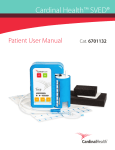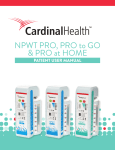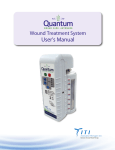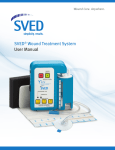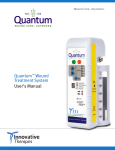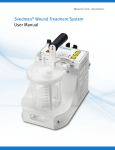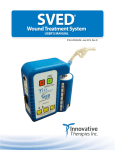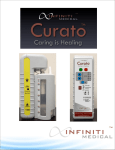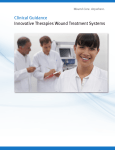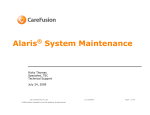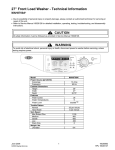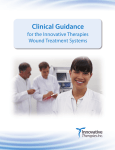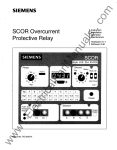Download Cardinal Health™ SVED®
Transcript
Cardinal Health™ SVED® Clinician User Manual Cat. 6701132 Clinician User Manual CAUTION: This Cardinal Health™ SVED® CLINICIAN User Manual is not a guarantee or warranty. It is intended only as an operational guide. For additional information and questions, please contact the Cardinal Health Customer Service department at1.866.484.6798. In order for the Cardinal Health™ SVED® to provide safe, reliable, and proper performance, the following conditions must be met. Failure to comply with these conditions will void all pertinent warranties. • There are no user serviceable components in the Cardinal Health™ SVED® device. All assembly, operation, adjustment, modification, maintenance, and/or repair must be carried out only by qualified personnel authorized by Cardinal Health. • The electrical installation of the room in which the device will be used complies with the appropriate national electrical standards. • The product must be used in accordance with this manual and all associated labeling and the Instructions for Use. • Any device that does not function as expected must be returned to Cardinal Health. Clinician User Manual Notice to Users: CAUTION: Federal law restricts this device to sale by or on the order of a physician. As with any prescription medical device, failure to follow product instructions or changing settings and performing therapy applications without the express direction and/or supervision of a trained clinical caregiver may lead to improper product performance and the potential for serious or fatal injury. Clinician User Manual Table of Contents 1. Introduction ����������������������������������������������������������������������������������������������������������������������������������������������������������������� 3. 1.1 Indications ��������������������������������������������������������������������������������������������������������������������������������������������������������� 3 1.2 Contraindications ���������������������������������������������������������������������������������������������������������������������������������������������� 3 1.3 Precautions ������������������������������������������������������������������������������������������������������������������������������������������������������� 3 1.4 Additional Precautions �������������������������������������������������������������������������������������������������������������������������������������� 3 1.5 Safety Tips ��������������������������������������������������������������������������������������������������������������������������������������������������������� 4 1.6 Features ������������������������������������������������������������������������������������������������������������������������������������������������������������ 6 2. Care & Cleaning ������������������������������������������������������������������������������������������������������������������������������������������������������������ 7 2.1 Introduction ������������������������������������������������������������������������������������������������������������������������������������������������������ 7 2.2 Protective Equipment ���������������������������������������������������������������������������������������������������������������������������������������� 7 2.3 Disposal ������������������������������������������������������������������������������������������������������������������������������������������������������������� 7 2.4 Daily Care and Cleaning ������������������������������������������������������������������������������������������������������������������������������������� 7 2.5 Between Patient and Weekly Care and Cleaning ����������������������������������������������������������������������������������������������� 8 3. Patient Care ������������������������������������������������������������������������������������������������������������������������������������������������������������������ 9 3.1 Applying the Dressing ��������������������������������������������������������������������������������������������������������������������������������������� 9 3.2 Canister Installation ���������������������������������������������������������������������������������������������������������������������������������������� 12 3.3 Canister Removal ��������������������������������������������������������������������������������������������������������������������������������������������� 14 3.4 Dressing Removal �������������������������������������������������������������������������������������������������������������������������������������������� 14 3.5 Disposal of Dressings, Canisters and Other Disposables ����������������������������������������������������������������������������������� 15 3.6 Utilizing Wound Irrigation ������������������������������������������������������������������������������������������������������������������������������� 15 4. Operating Instructions ������������������������������������������������������������������������������������������������������������������������������������������������ 17 4.1 Power ON/OFF ������������������������������������������������������������������������������������������������������������������������������������������������� 17 4.2 Power-Up Procedure ��������������������������������������������������������������������������������������������������������������������������������������� 18 4.3 Therapy Setting Adjustment ���������������������������������������������������������������������������������������������������������������������������� 18 4.4 Intermittent Mode ON/OFF ������������������������������������������������������������������������������������������������������������������������������ 19 4.5 Therapy Timer/Display ������������������������������������������������������������������������������������������������������������������������������������� 19 4.6 Alarm Volume Level Control ���������������������������������������������������������������������������������������������������������������������������� 19 4.7 Battery Operation �������������������������������������������������������������������������������������������������������������������������������������������� 19 4.8 Alarm Operation������������������������������������������������������������������������������������������������������������������������������������������������ 21 4.9 Therapy Selection Lock/Unlock������������������������������������������������������������������������������������������������������������������������� 22 5. Specifications ������������������������������������������������������������������������������������������������������������������������������������������������������������� 23 5.1 Symbols ����������������������������������������������������������������������������������������������������������������������������������������������������������� 24 5.2 Electromagnetic Compatibility ������������������������������������������������������������������������������������������������������������������������ 25 6. Replacement Parts ����������������������������������������������������������������������������������������������������������������������������������������������������� 27 7. Questions / Information ��������������������������������������������������������������������������������������������������������������������������������������������� 28 1. Introduction 1.1 Indications The Cardinal Health™ SVED® system is an integrated wound management system, indicated for the application of continual or intermittent negative pressure wound therapy to the wound as the device may promote wound healing by the removal of fluids, including wound exudates, irrigation fluids, body fluids and infectious materials. The Cardinal Health™ SVED® system is intended for patients with chronic, acute, traumatic, subacute and dehisced wounds, partial-thickness burns, ulcers (such as diabetic or pressure), flaps and grafts. The Cardinal Health™ SVED® system is intended for use in acute, extended and home care settings. 1.2 Contraindications Clinician User Manual The Cardinal Health™ SVED® system is contraindicated for patients with malignancy in the wound, untreated osteomyelitis, non-enteric and unexplored fistulas, or necrotic tissue with eschar present. Do not place the Cardinal Health™ NPWT Dressing over exposed blood vessels or organs. The Cardinal Health™ NPWT Dressings are also contraindicated for hydrogen peroxide and solutions which are alcohol based or contain alcohol. It is not recommended to deliver fluids to the thoracic cavity. 1.3 Precautions Precautions should be taken for patients with infected wounds, active bleeding, difficult wound hemostasis, or who are on anticoagulants. When placing the Cardinal Health™ NPWT foam dressing in close proximity to blood vessels or organs, take care to ensure that they are adequately protected with overlying fascia, tissue or other protective barriers. Exposed tendon, nerves or blood vessels should be protected by moving available muscle or fascia over them or by a layer of synthetic material. Greater care should be taken with respect to weakened, irradiated or sutured blood vessels or organs. Bone fragments or sharp edges could puncture a dressing barrier, vessel or organ. Wounds with enteric fistula require special precautions in order to optimize therapy. 1.4 Additional Precautions • Defibrillation: Remove the Cardinal Health™ NPWT Dressing if defibrillation is required in the area of dressing placement. Failure to remove the dressing may inhibit electrical current transmission and/or patient resuscitation. • Magnetic Resonance Imaging (MRI): The Cardinal Health™ SVED® device is not MRI-compatible. Do not take the device into the MRI area. • Hyperbaric Oxygen Therapy (HBO): NEVER allow a device—whether on or off—inside a hyperbaric chamber. The device must be disconnected from the patient prior to HBO treatment. • Large Canisters: Use of Large Canisters (>500ml) may increase serious risks associated with excessive fluid loss. Monitor patient status continually. • DO NOT USE for infants or other patients with low fluid volume, nor for patients at high risk of major hemorrhage. 3 • During Negative Pressure Wound Therapy, the Cardinal Health™ SVED® device and Cardinal Health™ NPWT Dressing are a closed system and are NOT vented to atmosphere. • During Negative Pressure Wound Therapy, when a canister fills with fluid, it should be replaced immediately as fluids such as wound exudate will not be removed from the dressing once the canister is full. Clinician User Manual When utilizing optional wound irrigation: • The Cardinal Health™ SVED® system is intended for use with saline solutions in a physiologic pH range that can optionally include topical wound treatment solutions. • Various topical agents, such as hydrogen peroxide, are not intended for extended tissue contact. If in doubt about the appropriateness of using a solution with the Cardinal Health™ SVED® system, contact the solution’s manufacturer. • Do not apply solutions in conflict with the manufacturer’s instructions for use. • During irrigation therapy, the Cardinal Health™ NPWT Dressing is a closed system and is NOT vented to atmosphere. • Do not use where temperature of fluid could cause an adverse reaction, such as a change in patient’s core body temperature. • During irrigation therapy, the irrigation bag should be checked periodically to ensure proper fluid delivery. In addition, when a canister fills with fluid, it should be replaced immediately as irrigation fluid and wound exudate will not be removed from the dressing once the canister is full. 1.5 SAFETY TIPS KEEP THERAPY ON The Cardinal Health™ SVED® device should be operated at least 22 hours out of every 24 hour period. Remove the Cardinal Health™ NPWT Dressing if therapy is terminated or is off for more than 2 hours in a 24 hour period. DRESSING CHANGES Clean the wound per physician order prior to dressing application. Routine dressing changes should occur every 48 to 72 hours. Dressing changes for infected wounds should be accomplished more frequently than 48-72 hours. Always replace with sterile disposables from unopened packages. Follow established institution protocols regarding clean versus sterile technique. MONITORING THE WOUND Inspect the dressing frequently to ensure that the foam is collapsed and that therapy is being delivered in a consistent manner. Monitor wound exudates for signs of active bleeding. Monitor periwound tissue and exudate for signs of infection or other complications.* Extra care and attention should be given if there are any signs of possible infection or related complications. Infection can be serious. With or without the Cardinal Health™ SVED® system, infection can lead to many adverse complications including pain, discomfort, fever, gangrene, toxic shock, septic shock, and various other complications. With signs of more serious complications of infection, discontinue use of the Cardinal Health™ SVED® system until the serious infection is diagnosed and properly treated. 4 DISCOMFORT/ADHERENCE If patient complains of discomfort during dressing change, consider pre-medication, use of a non-adherent wound contact layer prior to foam placement or irrigation of a topical anesthetic agent such as 1% Lidocaine prior to dressing removal. UNSTABLE STRUCTURES Over unstable body structures such as unstable chest wall or non-intact fascia, use the lowest pressure setting on the Cardinal Health™ SVED® device. SPINAL CORD INJURY In the event a patient experiences autonomic hyper reflexia (sudden elevation in blood pressure or heart rate in response to stimulation of the sympathetic nervous system) discontinue use of the Cardinal Health™ SVED® device to help minimize sensory stimulation. UNDERLYING STRUCTURES Underlying structures must be covered by natural tissues or synthetic materials that form a complete barrier between the underlying structures and the Cardinal Health™ NPWT Dressing. Clinician User Manual CARDINAL HEALTH™ NPWT DRESSING USE The Cardinal Health™ NPWT Dressings distributed by Cardinal Health are to be used exclusively with the Cardinal Health™ SVED® device. NOTE: All dressing components of the Cardinal Health™ NPWT Dressing kit are packaged sterile. The decision to use clean versus sterile/aseptic technique is dependent upon wound pathophysiology and physician/clinician preference. All components of the Cardinal Health™ NPWT disposable set are made without natural rubber latex. Be sure to comply with all other 1.2 CONTRAINDICATIONS and 1.3 PRECAUTIONS in the 1. INTRODUCTION section for the Cardinal Health™ SVED® User Manual. * Signs of possible infection may include fever, tenderness, redness, swelling, itching, and rash, increased warmth in the wound area, sudden increase in pain, purulent discharge or a strong odor. Nausea, vomiting, diarrhea, headache, dizziness, fainting, sore throat with swelling of the mucous membrane, disorientation, high fever (>102°F, 38.8°C), refractory hypotension, orthostatic hypotension, or periwound induration (a sunburn-like rash) may be added signs of more serious complications of infection. WARNING: Do not pack the Cardinal Health™ NPWT Dressings into any areas of the wound. Forcing dressings in a compressed manner into any wound is contrary to approved protocols. 5 1.6 Features Easy-to-use “One Touch” Operation: Therapy can be activated with the push of a single button. Therapy level can be quickly changed by pressing one of three buttons (70 mmHg, 120 mmHg and 150 mmHg). Therapy settings can be locked by the caregiver (see 4.9 THERAPY SELECTION LOCK/UNLOCK). Lighted membrane switches clearly indicate current setting to caregiver. Light Weight: The therapy device weighs 2.0 lbs (910 g) for increased mobility. NoiseGuard: Device is virtually silent in its normal operation with a well-sealed dressing. PowerGuard: An internal battery provides up to 18 hours of operation from a single full-charge. Battery charges while device is operating with the AC adapter. While running on battery, a low-battery alarm will “chirp” and the OFF button will begin flashing when remaining capacity of the battery is less than 20%. Clinician User Manual Intermittent Mode: The Cardinal Health™ SVED® device can be set to operate intermittently (5 minute ON /2 minute OFF cycle). Device maintains a 25 mmHg vacuum during the “OFF” state to prevent loss of dressing seal. TherapyGuard: Automated alarms for leak/low pressure and full canister. Alarms provide both a visual and audible indication. Alarms will self-reset once a problem is corrected or can be manually reset by turning the therapy device OFF and ON. I.V. Pole/Bed Hanger Adapter: Pole clamp permits the device to be mounted to a wide range of standard I.V. poles: 0.9” to 2.0” (2.2 to 5.0 cm) in diameter. SpeedConnect™: Eight-foot single-lumen tubing set with adhesive port facilitates connection to dressing. Single Patient Use Canister: 300cc and 500cc canisters with and without gel solidifier for normal and highly exudating wounds. CAUTION: Use of Large Canisters (>500ml) may increase serious risks associated with excessive fluid loss. Monitor patient status continually. DO NOT USE for infants or other patients with low fluid volume, nor for patients at high risk of hemorrhage. 6 2. Care & Cleaning 2.1 Introduction The following instructions are the Cardinal Health recommended cleaning and infection control procedures for the Cardinal Health™ SVED® device. The Caregiver should review this manual in its entirety before attempting to use the product. Carefully read the 1.3 PRECAUTIONS and 1.5 SAFETY TIPS in the 1. INTRODUCTION section before attempting to perform cleaning procedures on the Cardinal Health™ SVED® device. 2.2 Protective Equipment Clinician User Manual Universal Safety Precautions should be used to minimize the risk of infection and contact with contaminated blood or bodily fluids during the dressing changes or disposal and cleaning of the device; it is important to protect all exposed skin and mucous membranes. The protective equipment includes: • Disposable gloves (latex or latex-free). • Protective eyewear to help prevent splashing of cleaning solutions and/or blood or bodily fluids. • Protective mask (to protect the nose and mouth from inadvertent fluid ingress). • Disposable impervious gown (if splashing of blood or bodily fluids is possible). 2.3 Disposal After patient use, all disposable components of the system should be treated as contaminated. These include: • The Cardinal Health™ NPWT Foam Dressing components. • Exudate collection canister. • Tubing, connectors and clamps (and irrigation delivery set if irrigating). Dispose of all disposable components in accordance with local, state, and federal regulations and institution protocols. NOTE: Cleaning procedures should not be performed when device is connected to a patient. Disconnect the device from the patient and power source before cleaning or servicing. 2.4 Daily Care and Cleaning Perform a visual inspection of the device. Check for any sign of contamination and in particular any fluid ingress and ensure that the device is functioning properly. If the device is not operating properly, refer to the Alarm Troubleshooting guide in the 4. OPERATING INSTRUCTIONS section of this manual or contact Cardinal Health to replace the device. 7 2.5 Between Patient and Weekly Care and Cleaning To help reduce the risk of infection and contact with contaminated blood and bodily fluids please wear the protective equipment identified above when cleaning the Cardinal Health™ SVED® device. NOTE: Always follow Universal Safety Precautions. Follow established institution protocols regarding clean versus sterile technique. The following cleaning procedure must be performed at least once a week and must be completed between patients. The Cardinal Health™ SVED® device should be wiped with either a diluted solution of 5 milliliters bleach in 1 liter of warm water (approximately 1 teaspoon bleach in 1 quart water) or mild disinfectant. Use a coarse cloth and wring out any excess solution until the cloth is damp and not dripping. Other cleaning fluids are not recommended as they may damage the finish of the enclosure. Clinician User Manual A.C. Adapter Inspection The A.C. Adapter should be inspected regularly for damage and/or unusual wear. Replace damaged or worn Power Supplies immediately. A.C. Adapters are available from Cardinal Health. WARNING: The Cardinal Health™ SVED® device should only be used with the supplied A.C. Adapter. Use of an incorrectly rated adapter could create a shock hazard for the patient or caregiver and/or severely damage the device. WARNING: Avoid spilling liquid on any part of the device. Liquids can cause corrosion when left on electronic controls which can lead to failure. Component failure may cause the device to operate erratically, possibly causing a potential hazard to the patient or Caregiver. WARNING: Particular care must be taken when handling undiluted germicide concentrate or chlorine bleach, including proper shielding of eyes. Always mix by adding concentrated germicide or chlorine bleach to the water. NEVER intermix germicides or mix germicides with chlorine bleach. 8 3. Patient Care It is recommended that all sections of this manual be reviewed prior to using the product. Carefully read the 1.1 INDICATIONS, 1.2 CONTRAINDICATIONS, 1.3 PRECAUTIONS and 1.5 SAFETY TIPS in the 1. INTRODUCTION section before attempting to perform patient care with the Cardinal Health™ SVED® device. 3.1 Applying the Dressing 1.Cleanse wound according to institutional protocols or physician order. 2.Debride all necrotic tissue including eschar and slough. 3.Be certain the wound has achieved hemostasis. 4.Visually examine and palpate wound bed to locate any blood vessels or delicate underlying structure in close proximity. 5.Prepare area around wound to permit adhesion of the polyurethane drape. 6.Take measurements of the wound dimensions and note wound type. Select the appropriate foam based on wound assessment. Cut the Cardinal Health™ NPWT foam dressing to a size that is appropriate for the wound (Figure 1). Document the number of foam pieces used to fill the wound. NOTE: Do not trim the foam dressing over or around the wound site to help prevent debris from the foam dressing from falling into the wound (Figure 2). 7.Place the Cardinal Health™ NPWT foam dressing in the wound site taking care to avoid contact with the peri-wound skin (Figure 3). Figure 1 Figure 2 Figure 3 9 Clinician User Manual NOTE: If peri-wound area is excessively moist or oily, a medical-grade liquid adhesive may improve sealing. For fragile skin, use a skin sealant prior to drape application, or frame the wound with a skin barrier layer, such as a hydrocolloid, the Cardinal Health™ Drape or Cardinal Health™ SensiSkin™ Drape. Cut the drape to a size large enough to cover the foam and the barrier layer only. WARNING: Do not pack the Cardinal Health™ NPWT foam dressings into any areas of the wound. Forcing dressings in a compressed manner into any wound is contrary to approved protocols. Loosely fill all visible and invisible dead space in the wound. NOTE: The Cardinal Health™ NPWT foam dressing should cover the entire wound base, including tunneling and undermining. However, the Cardinal Health™ NPWT foam dressing should not be in contact with intact skin. 8.Size and trim the Cardinal Health™ Polyurethane Drape to cover dressing plus a 3-5 cm border of intact skin (extra pieces of drape can be used to seal dressing leaks) (Figure 4). A A A A A A A A 5 3- 3-5 cm A A A A Figure 4 C C C C C C C 9.Remove the drape’s release liner starting with tab A (Figure 5). Invert and place over the Cardinal Health™ NPWT foam dressing and peri-wound (Figure 6) and continue removing the contact layer with tabs B and C (Figures 7-8). Remove the remaining perforated tab (Figure 9). Gently press drape material down around the wound site and over the Cardinal Health™ NPWT foam dressing to ensure dressing is properly sealed. Figure 6 Figure 5 B B B C C C B B B B B C B C B C B C C C Clinician User Manual A cm A 5 cm A 3- 3-5 cm 10 Figure 7 Figure 8 Figure 9 10. Cut a 1 cm diameter hole in the top of the drape at a convenient location over the foam dressing by pinching and lifting the drape (Figure 10). 11. Peel the backing from the SpeedConnect™ port and place it over the hole made in Step 10 (Figures 11-12). Using the tips of the fingers, press around the top of the SpeedConnect™ to ensure a good seal to the dressing. 12. Connect the distal end of the SpeedConnect™ Tubing with the blue tapered connector to the open port of the Canister (Figure 13). Gently twist and push the connector on just enough to secure and seal it. Figure 11 Clinician User Manual Figure 10 Figure 12 Figure 13 11 3.2 Canister Installation 1.Ensure that a Cardinal Health™ NPWT Canister is properly inserted in the connector located on the side of the device (Figure 14). The canister should “snap” into place and lock. The canister release button may need to be depressed to permit canister insertion. NOTE: Always use a new canister with a new patient. Clinician User Manual Canister Release Exudate Collection Canister Figure 14 2.Inspect the SpeedConnect™ Tubing port(s) to ensure that they are properly connected to the Cardinal Health™ NPWT Dressing and that the connections are well sealed. 12 3.Connect the distal end of the SpeedConnect™ Tubing with the blue tapered connector to the patient port of the Canister (Figure 15). Gently twist and push the connector on just enough to secure and seal it. Also, make sure that the clamp on the SpeedConnect™ Tubing is open (Figure 15). Clamp SpeedConnect™ Tubing Connector Canister 4. Plug the device’s A.C. Adapter into a suitable 100-240 VAC, 50-60Hz outlet. Insert the power plug into the Power Connector on the side of the device (Figure 16). The Cardinal Health™ SVED® device should only be used with the supplied A.C. Adapter. Use of an incorrectly rated adapter could create a shock hazard for the patient and caregiver. Clamp Battery Charging Port Therapy Timer / Display Figure 16 5.Verify the dressing application is correct, the tubing is connected, and the Cardinal Health™ SpeedConnect™ Tubing clamp is open. 6.Begin therapy (see 4. OPERATING INSTRUCTIONS). 13 Clinician User Manual Figure 15 3.3 Canister Removal 1.Close suction tubing clamp. 2.Press the OFF button to turn the therapy off. 3.Disconnect SpeedConnect™ tubing from top of canister. Twisting the tapered connector will make removing the suction tube from the canister easier. 4.Press canister release button and withdraw canister from bottom of device. 5.Dispose of canister according to local, state and federal regulations as well as institutional protocols. NOTE: The canister should be replaced when full (the Canister Full alarm activates) or at least once every week to minimize the potential for contamination and production of odors. 3.4 Dressing Removal Clinician User Manual Carefully read the 1.5 SAFETY TIPS in the 1. INTRODUCTION section of this guide prior to removing the dressing. NOTE: Wounds must be carefully monitored at regular intervals. In a non-infected wound, dressings should be changed every 48 to 72 hours; but no less than 3 times per week, with the frequency of dressing change determined by the clinician. Infected wounds must be monitored continuously. For infected wounds, dressings may need to be changed more often than 48-72 hours; the dressing change interval should be based on a clinical evaluation of the wound condition rather than a fixed schedule. 1.With the device ON, lift a corner of the drape to allow air to enter the system. This will help move any fluid in the SpeedConnect™ tubing into the canister. 2.Close suction tubing clamp. 3.Press the OFF button to turn the therapy off. 4.Disconnect SpeedConnect™ tubing from top of canister. Twisting the tapered connector will make removing the suction tube from the canister easier. 5.Gently stretch the drape laterally and slowly pull up and away from skin. Lateral stretching of the drape will help release the adhesive and minimize trauma to the patient’s skin. NOTE: If the Cardinal Health™ NPWT foam dressing adheres to the wound during removal, refer to the 1.5 SAFETY TIPS section of this manual. 6.Remove all dressing materials from the wound. Count the foam pieces and compare to prior documentation (see Step 6 in 3.1 APPLYING THE DRESSING) to ensure complete removal. 7.Discard disposables in accordance with applicable rules, regulations and infection control protocols and always follow Universal Safety Precautions. 14 3.5 Disposal of Dressings, Canister and Other Disposables To minimize the risk of infection and contact with contaminated blood or bodily fluids during the dressing changes or disposal, it is important to protect all exposed skin and mucous membranes. The protective equipment includes: • Disposable gloves (latex or latex-free). • Protective eyewear to help prevent splashing of cleaning solutions and/or blood or bodily fluids. • Protective mask (to protect the nose and mouth from inadvertent fluid ingress). • Disposable impervious gown (if splashing of blood or bodily fluids is possible). After patient use, all disposable components of the system should be treated as contaminated. These include: • The Cardinal Health™ NPWT foam dressing and Cardinal Health™ Polyurethane Drape. • The Cardinal Health™ NPWT canister. • SpeedConnect™ tubing, connectors & clamps. 3.6 Utilizing Wound Irrigation with the Cardinal Health™ SVED® Device, optional The Cardinal Health™ SVED® device allows for the optional use of wound irrigation to the wound bed. NOTE: Wound irrigation should only be used with direct supervision of a trained clinician. Wound irrigation is not intended for use in a Home setting. NOTE: Any solution cleared for use in topical wound irrigation can be used as the wound irrigant. (See 1.1 INDICATIONS, 1.3 PRECAUTIONS, and 1.4 ADDITIONAL PRECAUTIONS) for more information on the suggested types of aqueous wound therapy solutions). Make sure the irrigation fluid supply remains off until therapy is started and target pressure achieved. 1.Obtain physician order for irrigation solution type and delivery rate. 2.Connect irrigation tubing set attachment to irrigation solution container. Close irrigation delivery set clamp completely. 3.Hang irrigation bag on IV pole higher than the wound. 4.Apply NPWT dressing as usual (see section 3.1 APPLYING THE DRESSING) (Figure 17). 5.Select desired location for Irrigation SpeedConnect™ port. Cut a 1cm diameter hole in the top of the drape where the Irrigation SpeedConnect™ is to be placed (Figure 18). 15 Clinician User Manual Dispose of all disposable components in accordance with local, state, and federal regulations and institution protocols. 6.Peel the backing from the Irrigation SpeedConnect™ port and place over hole made in Step 6 (Figures 19-20). Using the tips of the fingers, gently press around the Irrigation SpeedConnect™ port to ensure a good seal to the dressing (Figure 21). To Canister To Canister Clinician User Manual Figure 17 Figure 18 Figure 19 To Irrigation To Irrigation To Canister Figure 20 Figure 21 Note: The Irrigation SpeedConnect™ may be placed in close proximity to the suction SpeedConnect™, or in larger wounds may be placed over another area of the wound distal to the suction SpeedConnect™. 7.Turn device ON and allow dressing to reach set pressure. 8.Open the clamp and allow irrigation solution to flow until the irrigation solution begins to move through the suction SpeedConnect™ tubing and into the canister. 9.Set the drip rate per physician order. Note: drip rate does not need to be exact with continuous wound irrigation. Note: The irrigation rate will remain constant unless the therapy pressure setting is changed or if device is in intermittent mode. 16 4. Operating Instructions This section contains instructions for setting and adjusting functions of the Cardinal Health™ SVED® device. The section explains the procedure for activating therapy and explains the major functions that are adjusted from the control panel. Carefully read the 1.3 PRECAUTIONS and 1.5 SAFETY TIPS in the 1. INTRODUCTION section before attempting to operate and adjust the Cardinal Health™ SVED® device. WARNING: The Cardinal Health™ SVED® device should only be used with the supplied A.C. Adapter. Use of an incorrectly rated adapter could create a shock hazard for the patient or caregiver. The part number for the adapter can be found in the 6. REPLACEMENT PARTS section of this manual. 4.1 Power ON/OFF The ON and OFF to the therapy device. buttons are located on the front top of the control panel and control the application of power Clinician User Manual Battery Charging Port Canister Release Power ON Power OFF Canister Full Low Pressure / Leak Therapy Timer / Display 150 mmHg 70 mmHg 120 mmHg Figure 22 17 4.2 Power-Up Procedure 1.Verify the dressing application is correct, the tubing is connected, the SpeedConnect™ tubing clamp is open. 2.Keep the device in an upright position. The device can be placed on a table, or attached to an I.V. pole using the I.V. Pole adapter, but kept as level with or below the wound as possible. CAUTION: The I.V. pole clamp should only be used on poles that are in excess of 0.9 in (2.2 cm) diameter and are securely attached to a bed frame or suitable stand. To ensure stability of the therapy device on the I.V. pole, it should be clamped no higher than two times the width of the pole base. The clamp should be tightened to ensure that the therapy device cannot slide down the pole. 3.Press the ON button. All LED indicators will illuminate for 1 second during the power-on self-test, after which, the ON button will steadily light green. 4.Dressing should collapse indicating the presence of vacuum. 5.Carefully check dressing for vacuum or fluid leaks and repair with additional Polyurethane drape material as needed. Clinician User Manual 6.The Cardinal Health™ SVED® device should be operated at least 22 hours out of every 24 hour period. Remove the Cardinal Health™ NPWT Dressing if therapy is terminated or is off for more than 2 hours in a 24 hour period. 4.3 Therapy Setting Adjustment CAUTION: Only a physician can prescribe the proper settings and irrigation protocols for the therapy device. Failure to follow product instructions or adjusting settings and performing therapy application without the express direction and/or supervision of your trained caregiver may lead to improper product performance and the potential for serious or fatal injury. Adjusting Pressure Setting There are three pressure settings available: 70, 120, and 150 mmHg . The pressure selector buttons are located on the bottom front of the control panel. Use these buttons to select the therapy setting that is appropriate for the patient. 1.When the device is powered-up, the default setting of 120 mmHg is automatically selected (unless therapy setting has been locked previously by caregiver (see 4.9 THERAPY LOCK/UNLOCK)). 2.To change the Pressure Setting, press the desired Pressure Setting button. 3.The setting button will flash indicating the selection has been made and will continue flashing until the desired negative pressure level has been achieved at which time the button will stay illuminated. 18 4.4 Intermittent Mode ON/OFF The Cardinal Health™ SVED® device can operate in an intermittent suction mode with a 5 minute “ON” and 2 minute “OFF” cycle. To turn the intermittent mode on, press and hold the desired Pressure Setting button then momentarily press the OFF button. The device will beep twice and the ON button will begin flashing indicating the device is now operating in intermittent mode. Release both buttons. To turn the intermittent mode off (and return the device to the default continuous mode), repeat the above steps. The device will produce a single long beep and the ON button will steadily illuminate. The Cardinal Health™ SVED® device will remember the mode setting when the power is turned OFF and ON. During intermittent operation, the Cardinal Health™ SVED® device will provide target therapy pressure during the “ON” part of the cycle and approximately 25 mmHg during the “OFF” part of the cycle. This lower pressure setpoint during the “OFF” cycle maintains the integrity of the seal to prevent leaks. 4.5 Therapy Timer/Display (s/w ver.2.63 & higher) 4.6 Alarm Volume Level Control (s/w ver. 2.63 & higher) The volume of the alarm can be adjusted to fit various care settings or patient preferences. To adjust the alarm volume, press and hold the ON button while simultaneously pressing the yellow 150 mmHg button to increase the volume, or the 70 mmHg button to decrease the volume. The LED display on the side of the device will indicate the volume level which ranges from 1 to 5. The nominal alarm volume level for the device is 2, which is generally sufficient for most care settings. 4.7 Battery Operation NOTE: The Cardinal Health™ SVED® device is designed to permit use of the product while the internal battery is charging. The device will continue to operate properly while charging is taking place. Average Battery Life The specified battery life of the Cardinal Health™ SVED® device with a fully-charged battery is approximately 18 hours. The actual life is dependent on the integrity of the dressing. A leak in the dressing can reduce overall battery longevity significantly. 19 Clinician User Manual The Cardinal Health™ SVED® device has an LED Therapy Timer/Display (Figure 16) for displaying two types of therapy timers: Total Time accumulated by the device (non-resettable) and patient usage Therapy Time (resettable). The display will use the format: “d: days, H: hours, -: mins” and data will be displayed sequentially on the display. When the device is first turned ON, the Total Time is displayed. This timer cannot be reset and accumulates time as the device is used. After the device has displayed the Total Time and at any time the device is operating, pressing the ON button and 120 mmHg buttons simultaneously will initiate the display of Therapy Time. To reset the Therapy Time, press and hold the ON button and 120 mmHg button until the device beeps three times and the Therapy Time display indicates “d: 0, H: 00, -: 00”. Average Time for Recharging To ensure the battery has been fully charged, the device should be connected to an A.C. supply for approximately 3 hours. After approximately 2 hours of charging, the device will have achieved 80% of total battery capacity. Low Battery Alarm While running on battery, a low-battery alarm will “chirp” every 10 seconds and the OFF button will begin flashing when remaining capacity of the battery is less than 20%. Typically, the device will continue to operate for approximately 1 hour after the low-battery alarm is activated. Low Battery Shutoff If the battery charge falls below a critical level, the device will shutoff automatically and therapy will be discontinued. At this point, the device must be plugged into an A.C. power source for therapy to resume. Once the A.C. Adapter is plugged in, pressing the ON button will restart the device. Clinician User Manual Recharging the Battery Plug the power cord from the A.C. Adapter into the power connector on the side of the device. Plug the A.C. Adapter into a suitable 120 VAC, 60 Hz wall outlet. When the device is connected to an AC power source, the GREEN LED below the power connector will illuminate indicating AC power is present and the AMBER LED will illuminate when the battery is charging. Once the battery is fully charged, the AMBER LED will extinguish indicating the charge cycle is complete. When the Cardinal Health™ SVED® device is disconnected from the AC power source, the device will automatically switch over to the internal battery and continue to operate without interruption. 20 4.8 Alarm Operation Clearing an Alarm Condition To clear an Alarm Type, remedy the condition using the Troubleshooting table below. Once the condition is corrected, the alarm will automatically reset. To manually reset an alarm, turn the therapy device OFF then ON. The alarm will clear when the power is cycled. ALARM TYPE INDICATION CANISTER FULL • Canister Full LED lights accompanied by an intermittent audible alarm. • Device will continue to alarm until the canister is replaced LOW PRESSURE / LEAK • Low Pressure/Leak LED LOW BATTERY button will flash • The OFF accompanied by an intermittent audible “chirp” every 10 seconds. • The device will continue to alarm until connected to an A.C. power source • When the charge falls below a critical level, the therapy will be discontinued • Clamp the tubing • Turn device off by pressing the OFF • Remove canister and replace • Open the clamp and press the ON to resume therapy button button • Clamp the tubing • If Low Pressure/Leak LED and audible alarm reset, there is a leak below the clamp – often in the dressing. Reopen the clamp before addressing the leak. Gently press around drape to check for leaks. If leak is found, patch with extra drape material • If Low Pressure/Leak LED and audible alarm continue, there is a leak above the clamp. Check tubing connection at the canister. Check to ensure the canister is fully seated and locked. Check for cracks in the canister or lid separation. If found, replace the canister • Open the clamp • Utilizing an approved Cardinal Health A.C. Adapter, connect device to an A.C. power source to provide operating power and to recharge the internal battery NOTE: In the event of an emergency, please contact your treating physician, caregiver, or your local emergency responders. NOTE: If an Alarm Condition persists and cannot be resolved, please contact Cardinal Health for further assistance. 21 Clinician User Manual lights accompanied by an intermittent audible alarm • Device will continue to alarm until the low pressure/leak condition is corrected or the alarm is cleared CORRECTIVE ACTION 4.9 Therapy Selection Lock/Unlock The Cardinal Health™ SVED® device is equipped with a therapy locking feature designed to prevent unauthorized individuals from changing the therapeutic settings inadvertently. Locking To lock the device, press and hold the desired Pressure Setting button (70, 120, 150 mmHg) for three (3) seconds until three (3) audible beeps are heard. At this point, the device is locked. Pressing any other therapy level will result in three (3) beeps with no change in setting. This therapeutic setting will be recalled each time the device is powered OFF and ON, and the device will remain locked until it is subsequently unlocked by the caregiver. Clinician User Manual Unlocking To unlock the device, press and hold the selected Pressure Setting button (the lit button) until three (3) audible beeps are heard. At this point the device is unlocked and therapy settings can be changed. Additionally, when the device is powered OFF and ON, the device will remain unlocked and will automatically revert to the default setting of 120 mmHg . 22 5. Specifications Cardinal Health™ SVED® Device Dimensions������������������������������������������������������������������������������������������������������ 7.5 x 2.5 x 6.8 in. (19.05 x 6.35 x 17.27 cm) Weight��������������������������������������������������������������������������������������������������������������������������������������������������������� 2.0 Lbs (910 g) Therapy Settings��������������������������������������������������������������������������������������������������������������������������������70, 120 & 150 mmHg Canister Volume�����������������������������������������������������������������������������������������������������������������������������������������������300cc/500cc Medical Equipment with respect to electric shock, fire, and mechanical hazards only in accordance with IEC60601-1. Battery Duration (Fully Charged)�������������������������������������������������������������������������������������������������������������������������������up to 18 hours Electrical External Power Supply Input����������������������������������������������������������������������������������������������100-240 VAC, 50-60Hz, 700 mA External Power Supply Output��������������������������������������������������������������������������������������������������������������������15 VDC, 2 Amps Patient & Enclosure leakage Current�������������������������������������������������������������������������������������������������������< 100 Micro amps Environmental Conditions Storage Conditions Temperature Range���������������������������������������������������������������������������������������������������������������� 10°F (-12°C) to 110°F (43°C) Relative Humidity Range����������������������������������������������������������������������������������������������������������20 – 95% Non-condensing Atmospheric Pressure Range������������������������������������������������������������������������������������������������������������������ 50 kPa to 110 kPa Operating Conditions Temperature Range����������������������������������������������������������������������������������������������������������������������40°F (4°C) to 90°F (32°C) Relative Humidity Range����������������������������������������������������������������������������������������������������������� 20 - 75% Non-condensing Atmospheric Pressure Range������������������������������������������������������������������������������������������������������������������ 50 kPa to 110 kPa Service life of Cardinal Health™ SVED®��������������������������������������������������������������������������������������������������������������������� 3 years CAUTION: Federal law restricts this device to sale by or on the order of a physician. Specifications subject to change without notice 23 Clinician User Manual IEC Classification • Medical Equipment • Equipment not suitable for use in presence of flammable anesthetic mixture with air, oxygen, or nitrous oxide. • Continuous Operation • Type B Applied Part • Class II Internally Powered Equipment •IPXO 5.1 Explanation of Symbols Device Consult Instructions for Use Alternating Current Class II, Internally Powered Equipment Not protected against the harmful effects of water IPXO Type B Applied Part Clinician User Manual Dressings Consult Instructions for Use Method of Sterilization -Ethylene Oxide Expiry Date Date of Manufacture Lot/Batch Number Storage Conditions 24 Fragile Keep Dry Single Use Only Conforms with the Medical Device Directive (93/42/EEC) and has been subject to the conformity proceduress laid down in the council directive 5.2 Electromagnetic Compatibility The Cardinal Health™ SVED® device conforms to all pertinent requirements of IEC 60601-1-2. The EMC summary tables are provided herein below for your reference. Guidance and Manufacturer’s Declaration: Electromagnetic Emissions (IEC 60601-1-2) Emissions Test Compliance Harmonic emissions IEC 61000-3-2 Class A Voltage fluctuations / flicker emissions IEC 61000-3-3 Complies RF emissions CISPR 14-1 Complies Electromagnetic Environment The Cardinal Health™ SVED® device is suitable for use in all establishments, including medical facilities, domestic establishments and those directly connected to the public low-voltage power supply network that supplies buildings used for domestic purposes. The Cardinal Health™ SVED® device is not suitable for interconnection with other equipment. The Cardinal Health™ SVED® device is intended for use in an electromagnetic environment in which radiated RF disturbances are controlled. The customer or the user of the Cardinal Health™ SVED® device can help prevent electromagnetic interference by maintaining a minimum distance between portable and mobile RF communications equipment (transmitters) and the Cardinal Health™ SVED® device as recommended below, according to the maximum output power of the communications equipment. Output Power of Transmitter in watt(s) 0.01 0.1 1 10 100 Separation distance according to frequency of transmitter in meter(s) 150 kHz to 80 MHz 80 MHz to 800 MHz 800 MHz to 2.5GHz 0.12 0.38 1.2 3.8 12 0.12 0.38 1.2 3.8 12 0.23 0.73 2.3 7.3 23 For transmitters rated at a maximum output power not listed above, the recommended separation distance d in meters (m) can be estimated using the equation applicable to the frequency of the transmitter, where P is the maximum output power rating of the transmitter in watts (W) according to the transmitter manufacturer. Note: At 80MHz and 800MHz, the separation distance for the higher frequency range applies. Note: These guidelines may not apply in all situations. Electromagnetic propagation is affected by absorption and reflection from structures, objects, and people. 25 Clinician User Manual Recommended separation distance between portable and mobile RF communications equipment and the Cardinal Health™ SVED® Device Guidance and Manufacturer’s Declaration: Electromagnetic Immunity (IEC 60601-1-2) Immunity Test IEC 60601 Test Level Compliance Level Electromagnetic Environment Guidance Electrostatic discharge (ESD) IEC 61000-4-2 ±6 kV contact ±8 kV air ±6 kV contact ±8 kV air Floor should be wood, concrete, or ceramic tile. If floors are covered with synthetic material, the relative humidity should be at least 30%. Electrical fasttransient/ burst IEC 61000-4-4 ±2 kV for power supply lines ±1 kV for input/output lines ±2 kV for power supply lines ±1 kV for input/output lines Mains power quality should be that of a typical commercial and/or hospital environment. Surge ±1 kV line to line ±2 kV line to earth ±1 kV line to line ±2 kV line to earth Mains power quality should be that of a typical commercial and/or hospital environment. <5 % UT (>95 % dip in UT) for 0.5 cycle <5 % UT (>95 % dip in UT) for 0.5 cycle Mains power quality should be that of a typical commercial and/or hospital environment. 40 % UT (60 % dip in UT) for 5 cycles 40 % UT (60 % dip in UT) for 5 cycles 70 % UT (30 % dip in UT) for 25 cycles 70 % UT (30 % dip in UT) for 25 cycles <5 % UT (95 % dip in UT) for 5 sec. <5 % UT (95 % dip in UT) for 5 sec. 3 A/m 3 A/m IEC 61000-4-5 Clinician User Manual Voltage dips, short interruptions and voltage variations on power supply IEC 61000-4-11 Power frequency (50/ 60 Hz) magnetic field IEC 61000-4-8 Power frequency magnetic fields should be at levels characteristic of a typical location in a typical commercial or hospital environment. Note: UT is the A.C. mains voltage prior to application of the test level. Guidance and Manufacturer’s Declaration: Electromagnetic Immunity (IEC 60601-1-2) Immunity Test IEC 60601 Test Level Compliance Level Electromagnetic Environment Guidance Portable and mobile RF communications equipment should be used no closer to any part of the Cardinal Health™ SVED® device including cables, than the recommended separation distance calculated from the equation appropriate to the frequency of the transmitter. Recommend separation distance d = 1.2 √P d = 1.2 √P 80 MHz to 800 MHz d = 2.3 √P 800 MHz to 2.5 GHz Conducted RF IEC 61000-4-6 3 V rms 150 kHz ~ 80 MHz Radiated RF IEC 61000-4-3 3 V/m 800 MHz ~ 2.5 GHz 3 V rms where P is the maximum output power rating of the transmitter in watts (W) according to the transmitter manufacturer and d is the recommended separation distance in meters (m). Field strengths from fixed RF transmitters as determined by an electromagnetic site survey, a should be less than the compliance level in each frequency range.ь 3 V/m Interference may occur in the vicinity of equipment marked with the following symbol: Note1: At 80 MHz and 800 MHz, the higher frequency range applies. Note2: These guidelines may not apply in all situations. Electromagnetic propagation is affected by absorption and reflection from structures, objects, and people. a Field strengths from fixed transmitters, such as base stations for radio (cellular/ cordless) telephones and land mobile radio, AM and FM radio broadcast, and TV broadcast cannot be predicted theoretically with accuracy. To assess the electromagnetic environment due to fixed RF transmitters, an electromagnetic site survey should be considered. If the measured field strength in the location in which the Cardinal Health™ SVED® device is used exceeds the applicable RF compliance level above, the Cardinal Health™ SVED® device should be observed to verify normal operation. If abnormal performance is observed, additional measures may be necessary, such as reorienting or relocating the Cardinal Health™ SVED® device. ь Over the frequency range 150 kHz to 80MHz, field strengths should be less than 3 V/m. 26 6. Replacement Parts Device Cardinal Health™ SVED® device������������������������������������������������������������������������������������������������������������������������������6701132 Power Supply A.C. Power Adapter������������������������������������������������������������������������������������������������������������������������������������������������ 47-9000 Dressings Cardinal Health™ NPWT Small Foam Dressing Kit (10 per case)����������������������������������������������������������������������������� 47-1702 Cardinal Health™ NPWT Medium Foam Dressing Kit (10 per case)������������������������������������������������������������������������� 47-1701 Cardinal Health™ NPWT Large Foam Dressing Kit (10 per case)����������������������������������������������������������������������������� 47-1700 Cardinal Health™ NPWT X-Large Foam Dressing Kit (10 per case)�������������������������������������������������������������������������� 47-1703 Cardinal Health™ White Foam Dressing (10 per case)�������������������������������������������������������������������������������������������� 47-1751 Accessories Cardinal Health™ SVED® I.V. Pole/Bed Hanger Adapter������������������������������������������������������������������������������������������ 47-5500 Cardinal Health™ SVED® Canvas Carry Bag������������������������������������������������������������������������������������������������������������� 47-9500 Cardinal Health™ SpeedConnect™ Tubing�������������������������������������������������������������������������������������������������������������� 47-2000 Cardinal Health™ NPWT “Y” Connector������������������������������������������������������������������������������������������������������������������ 47-2500 Cardinal Health™ NPWT Polyurethane Drape (10 per pkg.)������������������������������������������������������������������������������������ 47-7000 Cardinal Health™ NPWT SensiSkin™ Drape (10 per pkg.)��������������������������������������������������������������������������������������� 47-7100 Cardinal Health™ NPWT Irrigation Tubing with SpeedConnect™ ��������������������������������������������������������������������������� 47-6000 NOTE: Part numbers for Canisters, Dressings and Disposable Accessories may be obtained by visiting the Cardinal Health website (www.cardinalhealth.com). NOTE: In order to assure the highest safety, quality and efficacy of the products, the Cardinal Health™ SVED® device should only be used with Cardinal Health™ NPWT components, and Cardinal Health™ NPWT components should only be used with the Cardinal Health™ NPWT Devices. 27 Clinician User Manual Canisters Cardinal Health™ Disposable Canister with Gel, 300 cc (10 per case)��������������������������������������������������������������������� 47-4000 Cardinal Health™ Disposable Canister with Gel, 500 cc (10 per case)��������������������������������������������������������������������� 47-4500 7. Questions & Information For additional information pertaining to the Cardinal Health™ SVED® device, please contact your local Cardinal Health representative, or: Call our customer support professionals at 1.866.484.6798 Cardinal Health Waukegan Rd, IL 60085 www.cardinalhealth.com [email protected] For questions or comments regarding the content of this User’s Manual, please contact Cardinal Health at the above address. Please contact Cardinal Health Customer Service at 1.866.484.6798 for issues concerning the product and its use. Clinician User Manual Always consult a physician and product instructions for use prior to application. Caution: Federal law restricts these devices to sale by or on the order of a physician. 28 Clinician User Manual 29 Cardinal Health 1500 Waukegan Road Waukegan, IL 60085 USA 07/15 cardinalhealth.com © 2015 Cardinal Health. All Rights Reserved. CARDINAL HEALTH, the Cardinal Health LOGO, SVED, SENSISKIN and SPEEDCONNECT are trademarks or registered trademarks of Cardinal Health. US Pat. 7,532,953, 7,608,066, 8,066,243. EMERGO EUROPE Molenstraat 15 2513 BH, The Hague The Netherlands

































